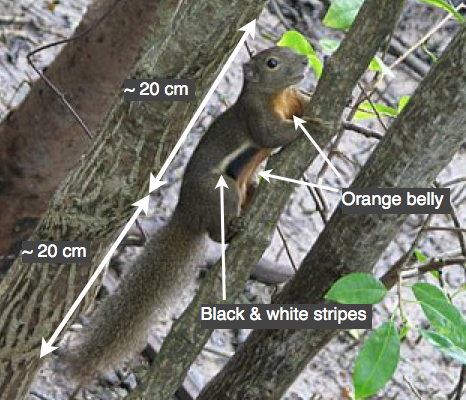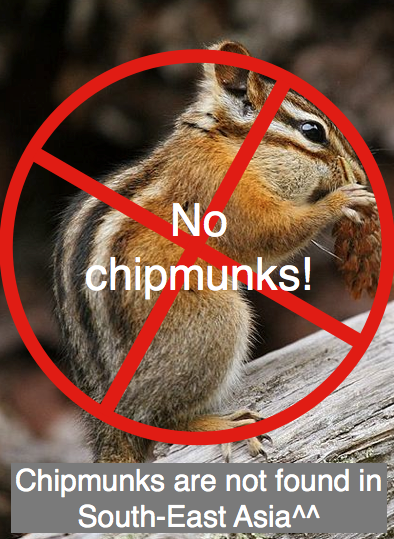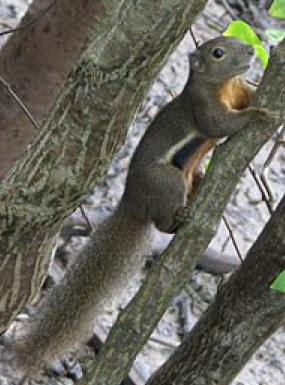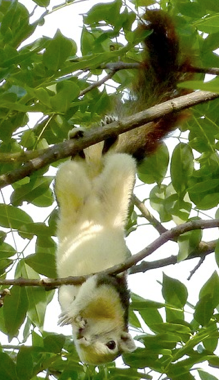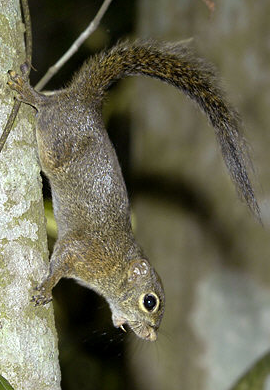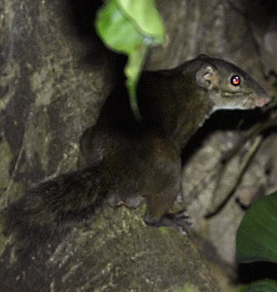Table of Contents
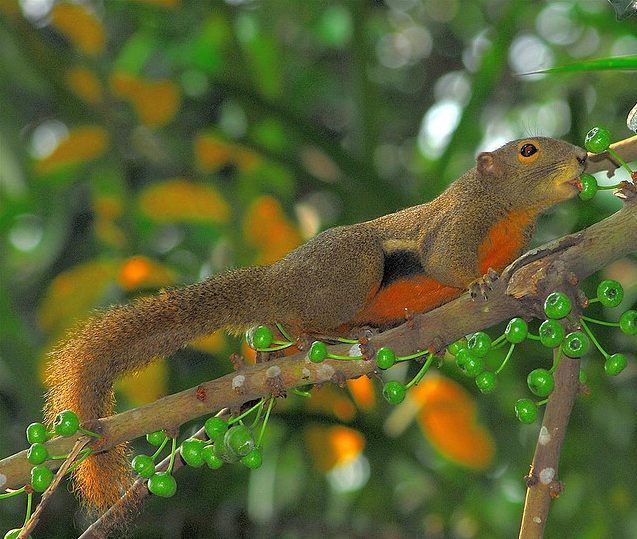
Do You Know?
- Plantain squirrels are one of the most common native mammals in Singapore [1]. (Long-tailed macaques are another notorious example.)
- Beautiful squirrels, aren't they? The taxonomic group they belong to, Callosciurus, literally mean "beautiful squirrels"!
- Teamwork! Plantain squirrels make different warning calls to alert nearby squirrels; for snakes, for predators in the air and on the ground [2].
<-------- For optimal viewing of this webpage, please expand your browser window until this line remains unbroken. --------------------------------------------------------------------------------------------->
Know Thy Squirrel!
|
Plantain squirrels are small, furry animals often found in parks and forest reserves in Singapore [1]. They have tails as long as their bodies as well as distinctive black and white stripes on their sides. Furthermore, one can see their brightly coloured orange belly, in contrast with the duller colours of their back. |
Be a Singapore Squirrel Expert!
Here are some squirrels found in Singapore's nature reserves and parks, learn to tell them apart!
|
|
|
|
|
||||||||||
| Common Name |
Plantain squirrel |
Finlayson's squirrel |
Slender squirrel |
Shrew-faced ground squirrel |
||||||||||
| Distinctive Characteristics |
Orange belly Sides with black and white stripes |
Diverse patterns: All or partly white, red or black |
Slender tail Plain coloured |
Long-nosed Short, bushy tail |
||||||||||
| Size |
Medium, ~ 20cm |
Medium, ~ 20cm |
Small, ~ 15 cm |
Medium, ~ 20cm |
||||||||||
| Native to Singapore? |
Native |
Introduced |
Native |
Native |
||||||||||
| Scientific Name |
Callosciurus notatus |
Callosciurus finlaysonii |
Sundasciurus tenuis |
Rhinosciurus laticaudatus |
Cream-coloured giant squirrels used to be found in Singapore too, but they have not been spotted since 1987 and are potentially extinct locally [1].
Biology of Plantain Squirrels
Diet
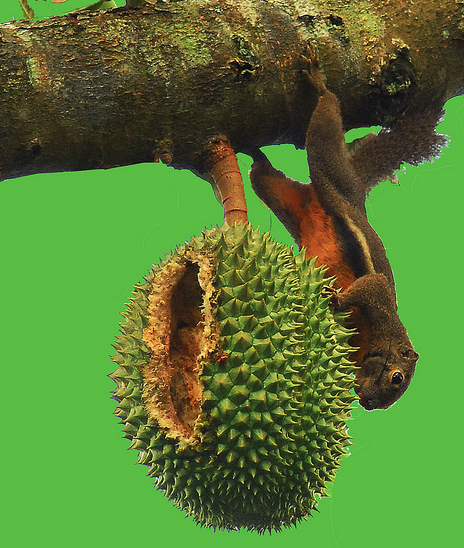 |
| Plantain squirrels love durians too! Photo by Johnny Wee. |
Plantain squirrel chewing on a variety of fruits.
Plantain squirrels eat:
- Fruits and leaves mostly, but also feed on bird eggs and insects where available [3].
- Around dawn, noon and dusk, as though they have three daily meals like us humans [5].
Communication
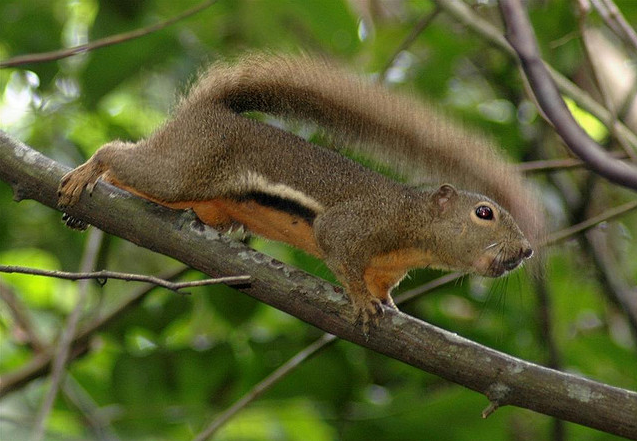 |
| Tail flicking by plantain squirrel. Photo by Johnny Wee. |
Plantain squirrels adapting well in Singapore (Clementi Woods Park). Tail flicks can be seen from 2:20s onwards.
Plantain squirrels communicate by:
- Tail movements to other members in their social group, look out for them in your next park visit!
- Vocalization; from mating, anti-predator alerts to group communication [2][6]. (Refer to table below)
| Situation |
Vocalization |
Reaction of Other Squirrels |
Significance |
|---|---|---|---|
| After mating |
Barks produced by male |
Female and other males stop moving |
Improves fertilization |
| Ground carnivore sighted |
Repetitious, staccato barks |
Other squirrels run up nearby tree |
Escape to trees to avoid ground predators |
| Aerial raptor (bird) spotted |
Single bark |
Other squirrels stop moving |
Avoid detection by reducing movements |
| Snake encountered |
Rattles and squeaks |
Converge on and mob snake |
Deter snake, protecting vulnerable young squirrels |
Catch a video of African Ground Squirrels mobbing a Cape Cobra on YouTube! (0:41s onwards).
Reproduction
- Female plantain squirrels can mate with up to four males over a seven-hour of mating period! [3]
- Most female squirrels are pregnant every month of the year, with a litter size between one and four [3].
- Male squirrels may guard females for up to three hours (or one minute only) to prevent other males from stealing the mate [6].
Ecosystem Roles
Plantain squirrels are:- Seed dispersers [3][5]. Urbanization has led to severe reduction in seed dispersers to regenerate our forests, plantain squirrels assist with the process [1].
- Preys to top predators (snakes, raptors, etc.) in the ecosystem and potentially sustain their population, which are often most severely impacted by habitat loss [2][7].
Distribution
Plantain squirrels are found in:- Secondary forests, parks and gardens in Singapore [1]. Elsewhere, they can be found in plantations, mangroves, swamp forests and fringe habitats [3].
- The Malay Peninsula, Borneo, Java, Sumatra, southern Thailand, and other nearby islands [8]. (Refer to map below)
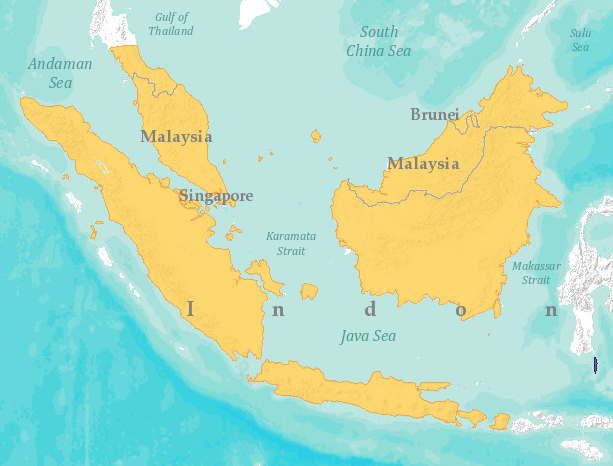 |
| Plantain squirrel distribution. Yellow: Native, Purple: Introduced. Adapted from IUCN Red List [9]. |
Conservation
Befitting their widespread presence and abundance, plantain squirrels are listed as:- Not Threatened in the Singapore Red Data Book (2008).
- Least Concern in IUCN, owing to their widespread presence and abundance in the region [9].
Taxonomy
Squirrels belong to the taxonomic group Sciuridae and evolved around 30 to 40 million years ago [3]. They are one of the largest group in mammals, with over 270 species across 50 genera [10]. The plantain squirrel belong to the group Callosciurus with 14 species in total [3]. It is the only native member of Callosciurus in Singapore, the other species, Callosciurus finlaysonii (Finlayson's squirrel) is an introduced species [3].Taxonavigation
| Common Name |
Group |
|---|---|
| Animals |
Animalia |
| Chordates |
Chordata |
| Mammals |
Mammalia |
| Rodents |
Rodentia |
| Squirrels |
Sciuridae |
| Southern Asian tree squirrels |
Callosciurinae |
| Beautiful squirrels |
Callosciurus |
| Plantain squirrels |
Callosciurus notatus |
Phylogeny
Phylogenetic studies of plantain squirrels remain unexplored, although other species in the genus have been studied.
Below are taxonomic studies of increasing exclusivity down to the group Callosciurus:
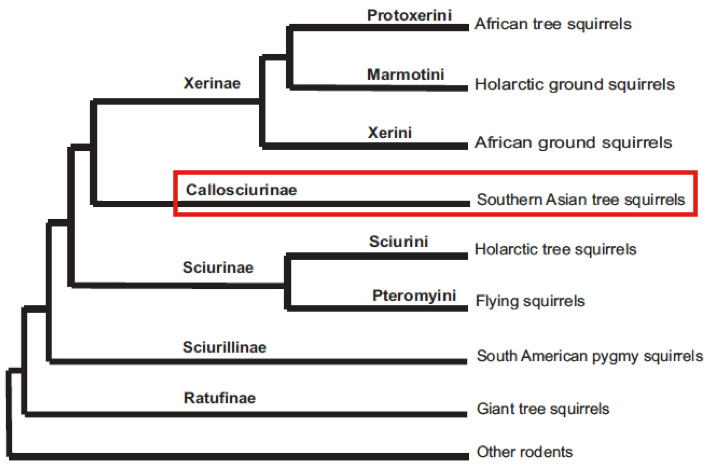 |
| Simplified Phylogeny of Squirrels (Sciuridae) [3]. |
Phylogeny of group Callosciurini, extracted from study by Steppan et al.[11]. The study was conducted using nuclear DNA (c-myc and RAG1, ~4500 bp) and lineage tree was constructed using parsimony, likelihood and Bayesian analyses.
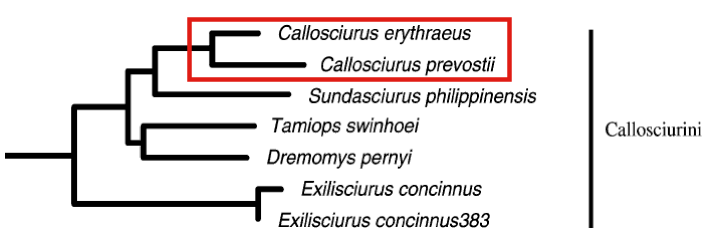 |
| Phylogeny of group Callosciurini, involving C. erythraeus & C. prevostii [11]. |
Oshida et al. conducted a phylogenetic study of five Callosciurus species using partial mitochondrial cytochrome b gene sequences (1080 bp) [12]. Tree construction was conducted using parsimony, neighbour-joining and likelihood analyses. This study provided greater support for the hypothesis that Callosciurus species are separated into mainland and Sundaland units.
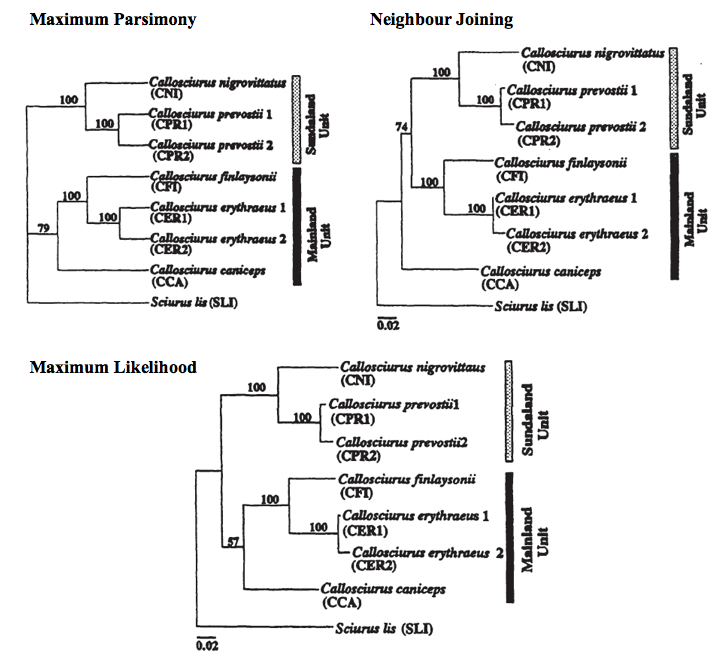 |
| Phylogeny of Five Callosciurus species [12]. |
Type Information [13]
Type specimens are crucial for species description and subsequent identification. This is especially true for a species such as the plantain squirrel, which was described more than two centuries ago!
| Location of Specimen |
Royal Belgian Institute of Natural Sciences |
| Catalogue Number |
450142 |
| Specimen Type Status |
Holotype |
| Type Locality |
Philippines |
Squirrel Links
Animal Diversity WebEcology Asia
Wild Singapore
Thank you for your visit and interest in knowing more about plantain squirrels.
Feel free to contact Yong Liang at the following email should you have any feedback:

References
[1] Tan, H.T.W., Chou, L.M., Yeo, D.C.J. and Ng, P.K.L. (2010). The National Heritage of Singapore (3rd edition), Prentice Hall, Singapore.[2] Tamura, N. and Yong, H.S. (1993). Vocalizations in response to predators in three species of Malaysian Callosciurus (Sciuridae), Journal of Mammalogy, Vol 74, 703-714.
[3] Thorington, R.W., Koprowski, J.L., Steele, M.A. and Whatton, J.F. (2012). Squirrels of the World, Johns Hopkins University Press, Maryland, United States of America.
[4] Mammal Species, National Parks Board. URL: www.nparks.gov.sg/cms/index.php?option=com_content&view=article&id=130&Itemid=128. Accessed 23 November 2012.
[5] Hafidzi, M.N. (1998). Plantain squirrel Callosciurus notatus in a plantation habitat, Journal of Tropical Agricultural Science, Vol 21, 23-28.
[6] Tamura, N. (1993). Role of sound communication in mating of Malaysian Callosciurus (Sciuridae), Journal of Mammalogy, Vol 74, 468-476.
[7] Becker, P. (1985). Why tropical squirrels carry seeds out of source crowns, Journal of tropical Ecology, Vol 1, 183-186.
[8] Encyclopedia of Life, Plantain Squirrel - Callosciurus notatus. URL: eol.org/pages/313042/overview. Accessed 15 November 2012.
[9] IUCN Red List, Callosciurus notatus (Plantain Squirrel). URL: www.iucnredlist.org/details/3600/0. Accessed 15 November 2012.
[10] Hoffmann, R.S., Anderson, C.G., Thorington, R.W.J., Heaney, L.R. (1993). Family Sciuridae. In: Wilson, D.E., Reeder, D.M. (Eds.), Mammal Species of the World. Smithsonian Institution Press, Washington, DC, pp. 419–465.
[11] Steppan, S.J., Storz, B.L. and Hoffmann, R.S. (2004). Nuclear DNA phylogeny of the squirrels (Mammalia: Rodentia) and the evolution of arboreality from c-myc and RAG1, Molecular Phylogenetics and Evolution, Vol 30, 703-719.
[12] Oshida, T., Yasuda, M., Endo, H., Hussein, N.A. and Masuda, R. (2001). Molecular phylogeny of five squirrel species of the genus Callosciurus (Mammalia, Rodentia) inferred from cytochrome b gene sequences, Mammalia, Vol 65, 473-482.
[13] GBIF Portal, Callosciurus notatus. URL: data.gbif.org/occurrences/442360784. Accessed 22 November 2012.
